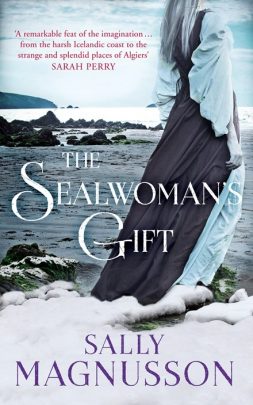
Knowing that The Sealwoman’s Gift, by Sally Magnusson, is a combination of fact, folklore, historical fiction and almost mythology makes for an intriguing and mesmerizing read.
A remarkable opening is set in 1627 with Asta, giving birth on the floorboards of a Barbary pirate vessel, surrounded by so many others who have also been brutally captured by the raiders, stolen from their Icelandic island and thrown as human cargo into the bowels of this ship.

I was a little put off by the long list of characters, all with unfamiliar mostly Icelandic names at the beginning of the book. However, the pages turn with compulsion and I did not refer to the list even once.
A clever mix of their present intermingled with vivid recollections of those catastrophic events that saw death, destruction and families split, is further tangled with folklore stories that bring them comfort.
The birth of Asta’s baby Jon is horrendous and this is followed by the death of old Odrum who is the ‘Sealwoman’, storyteller and foreteller of the future. What is the gift that she gives to Asta? It remains an enigma to the very end.
Olafur, husband to the spirited Asta and father to Helga, Egill, Marta and now baby Jon is the community priest. I tried to have empathy with Olafur. However, the further I read the more my antipathy toward him grew or was it the blindness of religion. Is this what the author intended?
The loss suffered from one island alone, over 200 out of a population of over 400 is unimaginable. However, in Algiers, the Asta family are ‘lucky’. Their eldest, Helga has not been captured. Their family of five, except for Egill are sold in the huge slave market together. The wealthy Moor, Cilleby, is the purchaser and will do with them as he wills. They cling to the possibility of ransom and return home. Olafur is sent on a journey by Cilleby to request ransom from the King of Denmark.
Cilleby, who has two wives, eventually summons Asta to his private domain. An interesting interaction, of words only, takes place. On the second summons, Asta finds herself ‘out of line’ and Cilleby is shocked to find himself ‘explaining’. Asta’s gaze is not fixed where it should be, she discovers he has blue eyes and he finds her privately ‘exhilarating’. After 6 years in Algiers Olafur is not so much on her mind. She finds joy in Marta, now 9 and Jon.
The clash of Christianity and Islam is a fascinating integral element in this saga. The acceptance of the present, adaptation of the human spirit (even if sometimes reluctantly) and will to survive are so very powerfully depicted in this skillfully told saga.
Tension keeps the reader completely spellbound as we suspect where certain aspects are going and always there is the question of Asta’s children. What happens to Jon, at the age of six and Marta at the age of 11. The wisdom of young Jon will help Asta eventually make a decision of her own free will.
Being judgemental and giving platitudes is so easy. This book can only enrich every single individual who reads this realistic but sometimes fanciful book.
The Sealwoman’s Gift, by Sally Magnusson, is available in hardback and paperback editions from the publishers, Hachette Australia – click here for details.